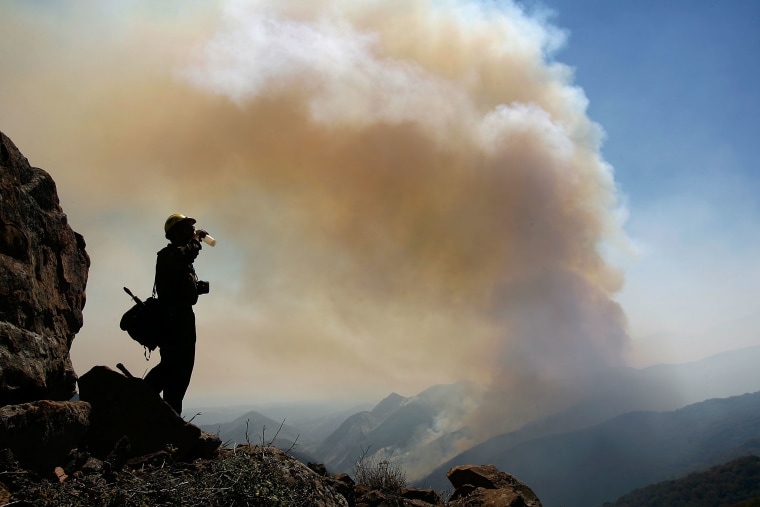In the past few years, Rich Nieto's work has started earlier and lasted longer.
The regional fire operations director for the Southwest Coordination Center said the West's fire season used to stretch from May into August or September, starting with blazes flaring up in the Southwest's arid spring.
But now fires touch off in April or earlier, and the season sometimes stretches into October, said Nieto, whose job entails allocating and moving ground-based firefighting resources.
"We have to adjust accordingly," he said.
A longer fire season can't be blamed solely on climate change or drought. More and more people want out of the cities and into the country — which in the West often means a place in the forest.
That raises the potential of more fires started by humans — cigarettes carelessly tossed; campfires that aren't dead; fires meant to burn weeds or garbage that instead get away.
In California, drought, high temperatures and lightning storms have contributed to more than 800 square miles being burned since June 20.
"What we're concerned about now is California is very active at a much earlier date than it usually is," said Don Smurthwaite, a spokesman for the National Interagency Fire Center in Boise, Idaho.
Dry spring turns grass into tinder
New Mexico's 2008 fire season has been driven partly by plentiful grass that sprang up in wet weather in 2007 but turned to tinder in this year's dry, windy spring.
The season began early with successive human-caused grass fires near Hobbs, N.M., in January, February and March that burned tens of thousands of acres, led to evacuations and destroyed several homes.
In addition, fire season is just beginning in the Great Basin states of Utah, Nevada, southern Idaho and eastern Oregon. As the summer moves on, the season will flow north into the Pacific Northwest as vegetation there dries out.
The fire center's 2008 Wildland Fire Outlook forecasts significant fire activity in California, parts of Nevada, the northern Rocky Mountains, Texas and West Virginia.
What's at risk determines who gets what resources.
Top priority goes to fires with the potential to harm human life, Nieto said. Second, fire managers need to keep enough reserves home to tackle new fires and get them out before they grow. Lastly, they consider the possibility a fire could destroy such things as major power lines, critical communication sites, cultural resources or special habitat.
The priorities sometimes prompt federal land managers to fight a smaller fire and send fewer resources to a larger one.
"A large fire may encompass a lot of area, but are there communities that could be endangered by that? There might not be," said Nieto, who has gone through 25 fire seasons.
20,000 seasonal firefighters
The U.S. Forest Service prepares for the heavy summer fire season well before it starts, hiring and training crews before it's time to suppress flames. This year, that's meant more than 20,000 seasonal firefighters nationwide.
The Forest Service's 11 geographic regions help each other — crews from Montana in the Northern Rockies Region, for example, have battled fires in New Mexico and Arizona this summer. As the Southwest fire season winds down with July rains, Southwest Region firefighters prepare to head north.
That's the normal routine.
But last week, the already fiery 2008 season and a forecast for more hot, dry, windy conditions in parts of the West prompted the National Multi-Agency Coordinating Group, made up of top federal and state fire managers from various agencies, to raise the nationwide preparedness level to 5 — the highest possible.
Resources already taxed
That means looking at national approaches, such as hot shot crews or aircraft, Nieto said. It might mean mobilizing the National Guard because other resources are exhausted, he said.
New Mexico called on National Guard Black Hawk helicopters to drop huge water buckets on a Manzano Mountain fires and last week sent two of the helicopters to California to help with its fires. California Gov. Arnold Schwarzenegger has ordered 200 guardsmen to report for training to augment fire lines — the first time troops there have been called to ground-based firefighting duty since 1977.
Daily conference calls work out priorities for crews and equipment, and the Forest Service, Bureau of Land Management, Bureau of Indian Affairs, state agencies and others cooperate with each other, Nieto said.
The new level 5 designation was based on three criteria: major fire activity in three or more of the 11 geographic areas; a large percentage of available fire crews and resources already committed; and an expectation that the fire season is only going to get worse, Smurthwaite said.
"All three boxes were checked 'yes'," he said.
